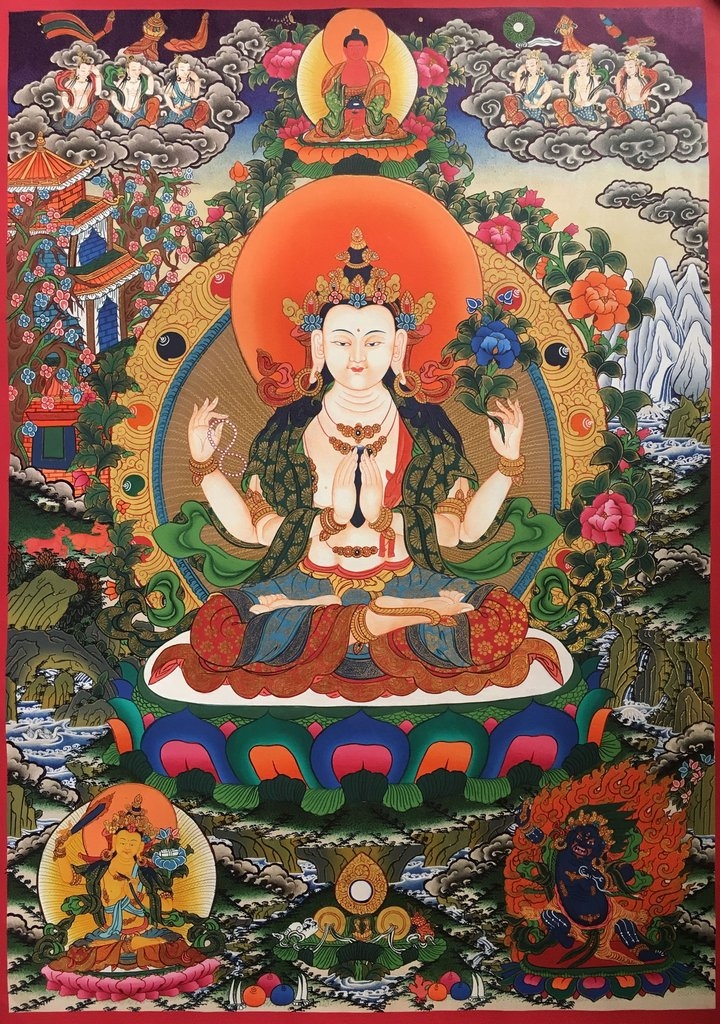Welcome home! Please contact lincoln@icrontic.com if you have any difficulty logging in or using the site. New registrations must be manually approved which may take several days. Can't log in? Try clearing your browser's cookies.
Thangka
 Lee82
Veteran
Lee82
Veteran
I always enjoy looking at Thangka and have just made this my phone background:

It occurred to me that I know little of the significance of all the secondary artwork. The centre character is Chenrezig but there’s so much other detail. Could anyone shed some light on the many other parts of the picture for me please?
I’d love one of these for the wall but they’re not cheap!
0

Comments
I've never done Chenrezig practice so i won't be of much help, But i'll make a few comments. First i know him as Avaloketoshavara, a symbol of compassion. He is seated on a lotus and moon disc, deities commonly are. I believe Mahakala a Dharma protector deity is in the lower right corner. I don't know in the lower left, maybe Manjushri symbol of insight, holding the sword of prajna in the right hand. Tibetan snow mountains in the mid right picture ( Tibet is the land of snow). Water is flowing out of the mountains. Buddha is mid top. I don't know the other figures at the top. Look up Avaloketoshavara and you'll find out the iconography associated with the Deity. Hope that helps, others may know a lot more, especially if they did the practice.
Where's @lobster ?
I believe @Tsultrim is right about Mahakala and Manjushri. The Buddha above is Amitaba, I'm not sure about the others at the top, maybe they are devas of some sort. The iconography gets pretty detailed, pretty much everything you see and even things you don't see have some sort of significance.
Yes it is Amitaba Buddha top centre, Chenrezig centre, Manjusri bottom left and Vajrapani bottom right. It’s interesting learning about the iconography from the paintings and gives me some sutras to want to read i.e the Surangama Sutra and the Lotus Sutra.
There are so many other details in the painting as well it would be great to know what they all represent and the connection between them.
When I see a Thangka painting I see patience, dedication and focus of attention
This looks like an interesting book on the subject...
https://www.amazon.co.uk/dp/B019PFLM0M/ref=dp-kindle-redirect?_encoding=UTF8&btkr=1
The central image is in fact Avalokiteshvara, who is also known as Chenrezig. Manjushri to the bottom left and Vajrapani on the bottom right. These are the 3 main bodhisattva's that Shakyamuni entrusted to spread his teachings (according to the Mahayana). Amithaba is at the top, being the principle diety of the Lotus Family to which Chenrezig belongs.
Chenrezig's colour, garment, objects, posture and so-forth all have specific meaning as it relates to different aspects of dharma practice.
Traditionally, thanks paintings were used as a practice support, in order to remind the practitioner of the various aspects of the visualization for whichever practice they were doing.
Though I did not go into great detail, I hope this helps a bit.
Cheapened by non-practice.

Cheap shot? It is the Manjushri in me ...
The sadhana or spiritual connection/practice of the personification of qualities
http://dharma-haven.org/tibetan/chen-re-zig.htm#Chenrezig
My most recent sadhana retreat involved Chenresig ... I created this reminder at the time ...
